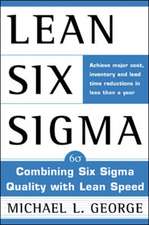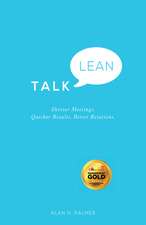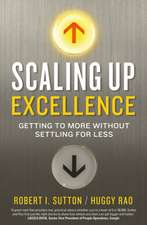Building Quality Management Systems: Selecting the Right Methods and Tools
Autor Luis Rocha-Lona, Jose Arturo Garza-Reyes, Vikas Kumaren Limba Engleză Hardback – 21 aug 2017
| Toate formatele și edițiile | Preț | Express |
|---|---|---|
| Paperback (1) | 288.70 lei 6-8 săpt. | |
| Taylor & Francis – 25 iun 2013 | 288.70 lei 6-8 săpt. | |
| Hardback (1) | 1042.56 lei 6-8 săpt. | |
| Taylor & Francis – 21 aug 2017 | 1042.56 lei 6-8 săpt. |
Preț: 1042.56 lei
Preț vechi: 1404.24 lei
-26% Nou
Puncte Express: 1564
Preț estimativ în valută:
199.50€ • 213.33$ • 166.33£
199.50€ • 213.33$ • 166.33£
Carte tipărită la comandă
Livrare economică 17 aprilie-01 mai
Preluare comenzi: 021 569.72.76
Specificații
ISBN-13: 9781138464056
ISBN-10: 1138464058
Pagini: 202
Dimensiuni: 178 x 254 x 19 mm
Greutate: 0.45 kg
Ediția:1
Editura: Taylor & Francis
Colecția Productivity Press
Locul publicării:Oxford, United Kingdom
ISBN-10: 1138464058
Pagini: 202
Dimensiuni: 178 x 254 x 19 mm
Greutate: 0.45 kg
Ediția:1
Editura: Taylor & Francis
Colecția Productivity Press
Locul publicării:Oxford, United Kingdom
Public țintă
Professional Practice & DevelopmentNotă biografică
Luis Rocha-Lona, Jose Arturo Garza-Reyes, Vikas Kumar
Cuprins
Preface, Acknowledgments, About the Authors, Abbreviations, 1. Introduction, 2. Business Excellence Models, 3. Process Management, 4. Quality Management Systems and Business Processes Diagnostic, 5. Strategic Quality Planning, 6. Building the QMS and Business Improvement Plan by Selecting the Right Models, Methods, and Tools, 7. QMS Implementation, 8. QMS and Business Processes Evaluation, 9. Beyond Quality Management Systems
Descriere
Current and emerging trends in the domains of health management and the work sector, the abundance of new consumer products pervading the marketplace, and the desires of many older adults to undertake new learning experiences means that older adults, like their younger counterparts, will need to continually engage in new learning and training. Thus, understanding the challenges that older people face when confronted with new learning and training programs and developing potential strategies to overcome them is imperative. A comprehensive state-of-the-science review, Designing Training and Instructional Programs for Older Adults explores a broad range of issues, from the implications of theories of learning for designing instruction for older adults to adapting current perspectives on methods of instructional design to accommodate the capabilities and limitations of older learners. The authors provide an understanding of today‘s older adults their demographics, their needs, the challenges facing them, and a realistic appraisal of their abilities and limitations as a basis for how current knowledge about training and instructional design should be shaped and applied to best accommodate this population of learners. They discuss topics such as retention and transfer of training, sequencing the order of instruction, e-learning, multimedia training formats, and the assessment and evaluation of training programs from the perspective of issues relevant to older learners. They also highlight the challenges presented by this very heterogeneous group that varies tremendously in backgrounds, skills, knowledge, and abilities.Focusing on how learning occurs, the authors balanced coverage makes the book readable and enlightening across a wide spectrum of professionals and academics, including human factors/ergonomics specialists, gerontologists, managers, educators, undergraduate and graduate students, and the design community. The bo










